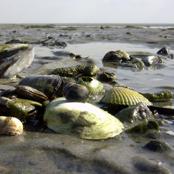Archaomalacology – molluscs
Archaeomalacology is the study of primarily bivalves and snails from archaeological excavations and past marine deposits. The shells and valves reveal information of past marine environments and the use of marine resources by human societies.

Molluscs
Molluscs are a significant part of marine life at the sea floor, especially in inshore areas. Their sturdy shells and valves often remain in the soil and may survive for thousands or even millions of years. They are found on the seabed where they once lived and at breakwater in beach deposits. But they are also a frequent find on many archaeological excavations, as refuse from human collection activities. In such deposits they may represent:
- a food resource
- marine and lacustrian environmental reconstruction
- a raw material (e.g. tools, lime plaster)
- dyeing
- ornaments and decorations
In archaeological contexts snails and mussels are typically the most frequently found molluscs and they include a number of different species which were of interest to past societies both economic and symbolic significance
Identification to species or family is at the beginning of any analysis. In many cases the same species can found in local waters today. But in some instances the distribution of species will differ due to changes in climatic conditions, ocean depth and salinity.
A basic list of species, the frequency of each species and shifts in size and appearance of the shell may all reveal information about local environmental conditions in the past. Similarly, variation in species diversity in a kitchen midden may identify changing human dietary habits.
The mollusc reference collections at the Natural History Museum of Denmark are of the highest international standing and one of the oldest in Europe, containing both modern and archaeological specimens. All relevant west Eurasian species are represented here and as such, the collections are an invaluable tool in the identification process.
Mollusc shells are also used for other types of analyses: amino acid- and DNA analyses of the shell and isotope analysis of the growth rings can be used in seasonality studies and in determination of environmental periods of local bloom and slump. Finally, the mollusc shells are also useable for 14C dating.
The optimal sampling strategy depends on the frequency of molluscs: When the shells are present as a compact layer, extraction of local samples will often be sufficient. If the shells occur dispersedly in the sediment, the molluscs can often be collected together with other faunal remains by hand and during sieving or flotation.
Kontakt

Pernille Bangsgaard
Senior forsker
Speciale: Dyreknogler
Telefon: +45 51 31 79 38
Email: pernille.bangsgaard@sund.ku.dk
Svend Funder
Ass. Professor Emeritus
Research: Molluscs
Phone: +45 35 32 23 63
Mobile: +45 26 83 23 53
Email: svf@sund.ku.dk
